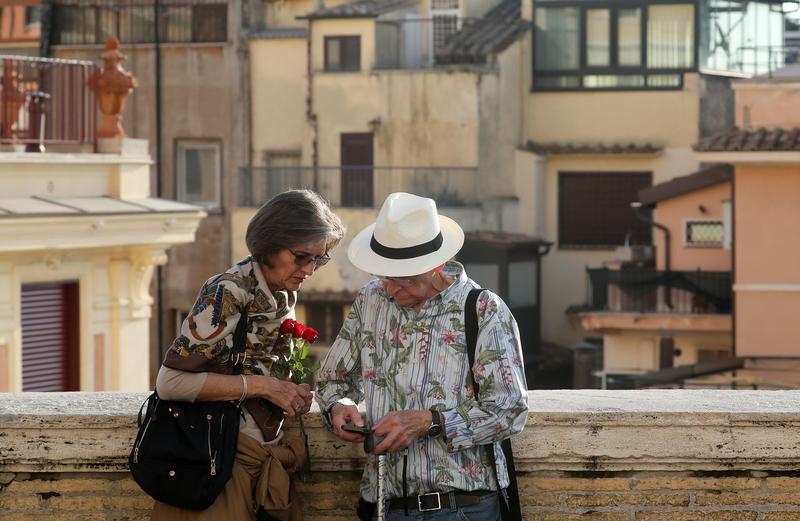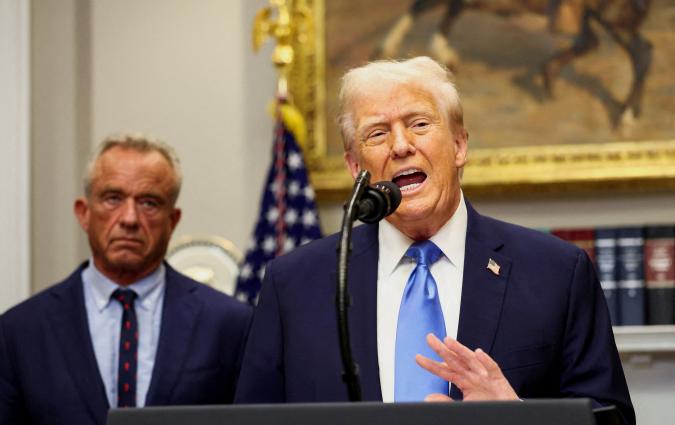A WhatsApp course taught older Spaniards to spot misinformation. New research suggests it worked (to an extent)

REUTERS/Alessandro Bianchi
Journalists and researchers in Spain teamed up to trial a course to teach older generations how to recognise misinformation online. The course was delivered on WhatsApp, an app that 27% use for news in Spain. A group of academic researchers studied whether the course helped the people who took it. According to their findings, to an extent, it did.
US-based initiative MediaWise and Spanish news outlet Newtral built and delivered the course to a Spanish audience. Then researchers from the University of Navarra studied the impact of the course in a sample group of over-50s in Spain. They found that those who took the course were more successful in identifying the news as true or false than the members of a control group.
I spoke to Marilín Gonzalo from Newtral and Charo Sádaba from the University of Navarra to learn more about this innovative WhatsApp course and to discuss what we can learn from the project about the attitudes of older news audiences and about the way misinformation spreads online.
Why the course matters
As survey data from our Trust in News Project shows, older people tend to trust news less than younger people, and this gap in trust is even wider when it comes to news on digital platforms. Some of this difference could be explained by the fact that older people are less likely to use online platforms for news in comparison to younger people, our researchers write.
Social platforms are also places where news from reputable sources may be displayed side by side with misinformation, and this could create confusion for people who are not as familiar with this digital environment. MediaWise’s course aimed to help older people make this tricky distinction.
What the course is like
MediaWise is part of the Poynter Institute and runs a range of digital programmes to help people recognise online misinformation. As well as addressing the issue among the youngest generations, the institute is also interested in promoting digital and news literacy competencies among elderly people.
They first started in the United States, with a short self-directed course to help older people recognise mis- and disinformation, available in English and Spanish. Then Mediawise decided to expand this initiative into other countries, and worked with local partners to adapt it to the languages and contexts of Brazil, Guatemala, France, Turkey and Spain.
To cater their course to Spain, MediaWise partnered with Newtral, a media start-up focused on the production of TV programmes, news stories and innovative projects on digital platforms.
“They chose us because we had this audiovisual experience. They wanted the course to have short videos because they thought it was much more effective,” said Marilín Gonzalo, who is the Head of Public Policy at Newtral and author of a column about media and technology.
Like other media start-ups, Newtral has a young online audience on most platforms. However, the audience of their newsletters is older. Sometimes, some of these older readers would reply to the newsletters with questions about disinformation. “So we detected that there's a group of people that is very vulnerable to this kind of disinformation,” Gonzalo said. ”Sometimes they just don't have the tools or the knowledge to know if [what they’re seeing online] is true.”
Newtral’s team designed ten daily sessions, made up of a WhatsApp message, question and video, with examples that would be recognisable to their audience.
The course’s contents ranges from more general topics like defining misinformation and distinguishing opinion and fact, to practising specific skills like how to identify the main channels disseminating hoaxes, and the signs to look for when questioning the veracity of a piece of news, Gonzalo said. The course was launched to the public in April 2023 and is still available for new sign-ups.
Was the course useful?
Researchers Charo Sádaba, Ramón Salaverría and Xavier Bringué-Sala, from the University of Navarra, were asked by MediaWise to independently research whether the course had produced any impact. The US-based course was also assessed by Stanford Social Media Lab researchers.
Both studies showed that the group of older adults who took the courses was able to more accurately distinguish real and fake news after the course than they were before it.
The study was launched at the same time as the course was made available to the public, but focused on a sample group of 1,029 individuals over 50 who lived in Spain and were smartphone users. This was split into a test group, which would take the course, and a control group, which would not.
I spoke to Charo Sádaba, Dean and Full Professor at the University of Navarra’s Faculty of Communication and the lead author of the report, about the key findings of this study.
“The first thing we observed is that this age group are interested in news,” she said, adding that those with right-wing political leanings tended to be more critical of left-wing content and vice-versa, as might be expected. “But the interesting thing,” she added, “is that after taking the course, they were more aware that perhaps news related to or closer to their own [political] opinions could also be biased.”
Out of the 498 course participants analysed, only 190 attended at least one session, and out of those, 87 had attended five or more sessions. The researchers’ analysis was based on this latter, smaller group in order to better assess the impact of having taken the course. Participants who had attended five or more sessions were better at recognising true and false headlines after the sessions than they had been before.
However, there was a difference in this group's ability to correctly identify true headlines and correctly identify false headlines: the group distinctly showed improvement in the former, but less so in the latter.
There was no clear pattern found when it came to age, gender and educational differences between individuals involved in the study. It doesn’t appear that any of these factors significantly affected individuals’ ability to recognise true and false news, the researchers concluded.
The role of WhatsApp
The course was delivered via WhatsApp because of the platform’s popularity in Spain, as well as the recognition that the platform itself hosts a lot of disinformation. According to our Digital News Report 2023, 79% of people in Spain use WhatsApp for any purpose, and 27% of people use it for news, making it the second most popular social platform for news after Facebook.
“Both Newtral and MediaWise thought that WhatsApp is one of the main channels where disinformation roams freely,” Gonzalo said. “Most of the disinformation runs in private channels or private conversations, so we can’t look at it to verify this information.”
Newtral’s approach to countering this was establishing its own WhatsApp presence, which predates the launch of the course.
“We launched our first channel on WhatsApp in 2018 so people could ask us if any piece of content was fake or not. So we have a very good repository of information about what people are asking and what kinds of hoaxes are circulating in this channel,” Gonzalo said.
However, Sádaba thinks that WhatsApp may not have been the best medium to deliver the course to this particular age group. She says that the difficulty in retaining course participants, which reduced the size of the experimental sample, may be due to the novelty of using WhatsApp as an educational tool, moving beyond the private communication it’s known and used for by most people.
“Perhaps it has something to do with the digital competence of this age group,” Sádaba said. “It was difficult for those 500 people taking the course to complete the ten sessions, and we think that this has something to do with the difficulty of understanding that WhatsApp could be a tool to learn something” and not just a platform to talk to family and friends.
How misinformation travels in Spain
A study conducted by the University of Navarra in 2022 in collaboration with UTECA, an association of commercial TV media outlets, found that 91% of respondents consider disinformation a danger to democracy and the stability of the country.
“This information is usually linked not to traditional media, but to all these kinds of outlets, probably social media, and some profiles on social media that are producing disinformation. Sometimes you read that kind of content precisely through WhatsApp,” says Sádaba, who stresses Spain is similar on this to other Western countries.
When misinformation is posted on social media by accounts unrelated to news organisations, this can affect people’s perception of news, Sádaba said. “It's important for the news media to take this into account,” and be more careful about this, she said. For example, journalists should be transparent about any corrections they make to online articles, and explain any changes in an editor’s note.
“Perhaps the course is too short to assure a real or a better change because we are trying to change attitudes and behaviours, which are very difficult to change,” she said. “But what our study shows is that with very little you can create a small change, and that's good but not enough. So perhaps the solution is a mix of several things: improving the courses and addressing this population, but also improving how news outlets are working.”
Gonzalo agrees with Sádaba and says that news organisations ought to play an important role in helping older audiences identify misinformation and turn to more reliable sources of news. She stresses that many digital tools are not designed with older audiences in mind, and this can create a dangerous gap.
Small adjustments can make a wide range of content more accessible to older people, such as using larger fonts on websites and short-form videos, Gonzalo suggested.
Asked who should take on the responsibility of teaching disinformation, both Sádaba and Gonzalo pointed to a wide coalition: media organisations, fact-checkers, NGOs, Big Tech and governments should work together to address this issue. “Everyone could be implicated in this,” Sádaba said.







